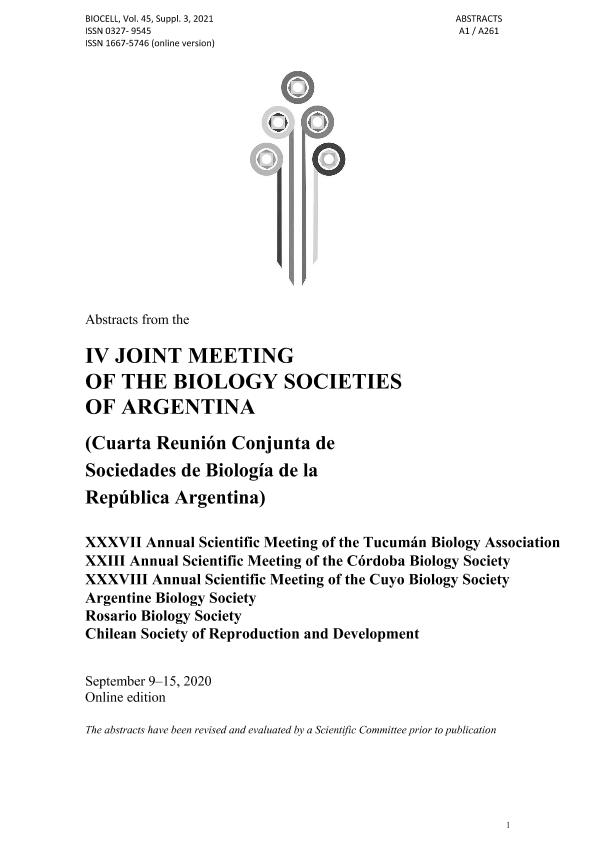Evento
Effect of botulinum neurotoxins from Mendoza of clostridium botulinum strains on cytoskeletal proteins of mammary tumor cells
Chapana, Agostina Lucía; Guarniolo, D.; Carvelli, Flavia Lorena ; Sosa, E.; Fernández, R. A.; Sosa, M. A.; Caballero, P. A.
; Sosa, E.; Fernández, R. A.; Sosa, M. A.; Caballero, P. A.
 ; Sosa, E.; Fernández, R. A.; Sosa, M. A.; Caballero, P. A.
; Sosa, E.; Fernández, R. A.; Sosa, M. A.; Caballero, P. A.
Colaboradores:
Piezzi, Ramon Salvador

Tipo del evento:
Reunión
Nombre del evento:
IV Reunión Conjunta de Sociedades de Biología de la República Argentina
Fecha del evento:
09/09/2020
Institución Organizadora:
Sociedad de Biología de Cuyo;
Sociedad Argentina de Biología;
Sociedad de Biología de Rosario;
Sociedad Chilena de Reproducción y Desarrollo;
Asociación de Biología de Tucumán;
Sociedad de Biología de Córdoba;
Título de la revista:
Biocell
Editorial:
Tech Science Press
ISSN:
0327-9545
e-ISSN:
1667-5746
Idioma:
Inglés
Clasificación temática:
Resumen
The botulinum neurotoxin serotype A (BoNT A) produced by Clostridium botulinum, which causes botulism, is used for the treatment of multiple neurological diseases and its therapeutic action against cancer is currently being evaluated. In previous studies, we have shown that BoNT A from autochthonous soil strains (Su) have different properties than the reference A Hall strain. Among these, its molecular structure, its enzymatic activity against brain SNARE proteins and its greater specific toxic activity (AE) stand out. In cells from human mammary carcinoma (MCF-7) treated with BoNTs for 45 min, we found a marked effect on the expression of cytoskeletal proteins. Therefore, in this work, we delve into the study of the action of autochthonous BoNTs A and prototype A Hall on the distribution of actin and tubulin in these cells. Native forms of autochthonous BoNT (Su strains 1935 and 1891, Tupungato) and prototype A Hall were purified by saline precipitation. Their AE values (LD50 / mg protein) were established and their electrophoretic characteristics were evaluated under non-denaturing conditions. 250 LD50 of the BoNTs were incubated to MCF-7 cell cultures for 10 or 25 min. Later, the cells were fixed and processed for indirect immunofluorescence with the use of specific antibodies that recognize tubulin or actin. The samples were visualized by fluorescence microscopy. At the two times evaluated, the three types of BoNTs produced a marked redistribution of the actin cytoskeleton, patch form, on areas coinciding with the plasma membrane. Tubulin was redistributed to multiple areas with high signal density at 10 min of incubation only in the presence of BoNT 1891. At 25 min of incubation, the cells treated with BoNTs 1891 and 1935 showed this effect, while in those incubated with A Hall, the distribution of these proteins was not modified. The notable alterations in the distribution of components of the tumor cell cytoskeleton by BoNT from native strains of Mendoza soils open new perspectives for therapy against solid tumors.
Palabras clave:
BOTULINUM NEUROTOXIN
,
BREAST CANCER
,
CYTOSKELETON
Archivos asociados
Licencia
Identificadores
Colecciones
Eventos(IHEM)
Eventos de INST. HISTOLOGIA Y EMBRIOLOGIA DE MEND DR.M.BURGOS
Eventos de INST. HISTOLOGIA Y EMBRIOLOGIA DE MEND DR.M.BURGOS
Citación
Effect of botulinum neurotoxins from Mendoza of clostridium botulinum strains on cytoskeletal proteins of mammary tumor cells; IV Reunión Conjunta de Sociedades de Biología de la República Argentina; Argentina; 2020; 16-16
Compartir



